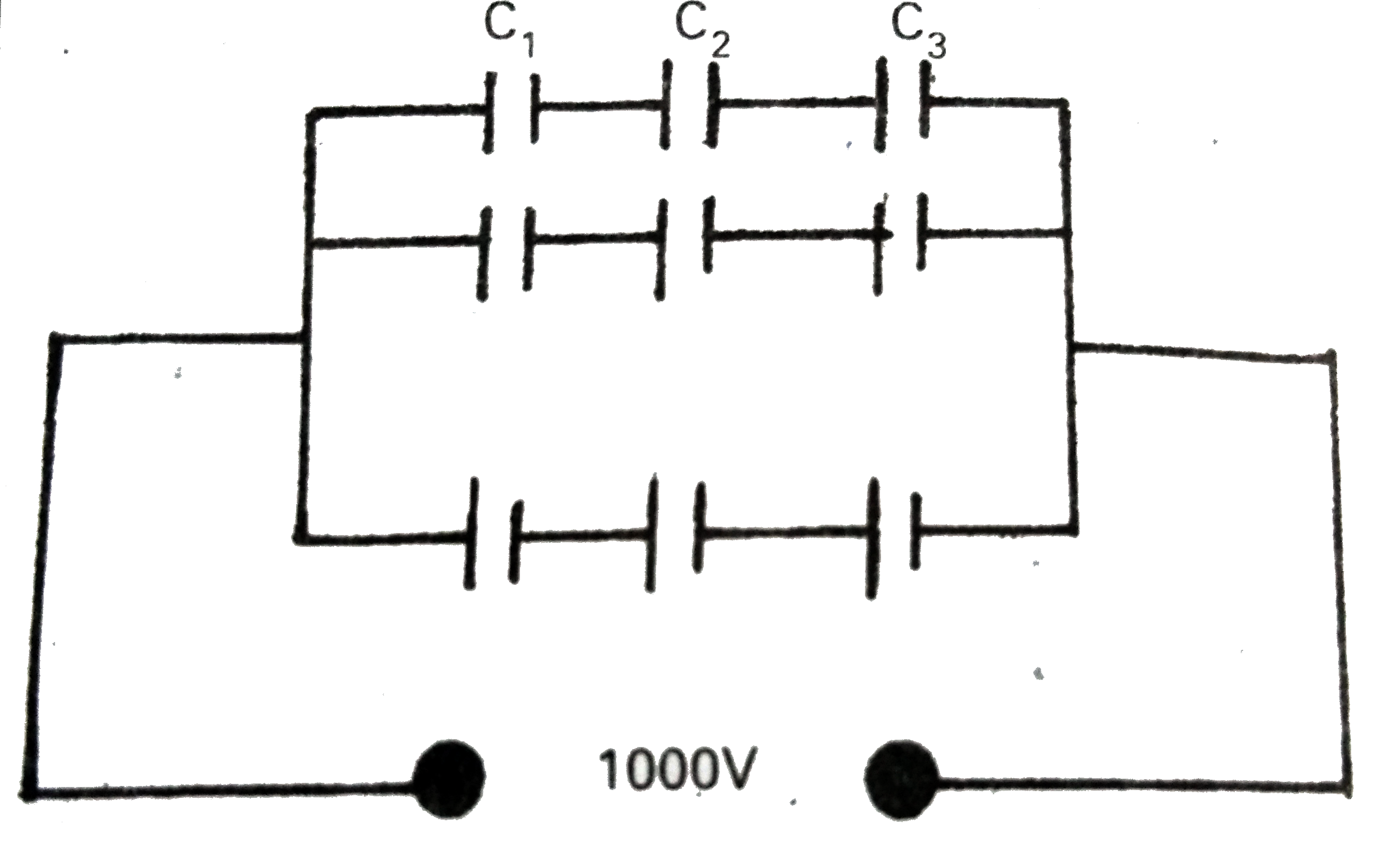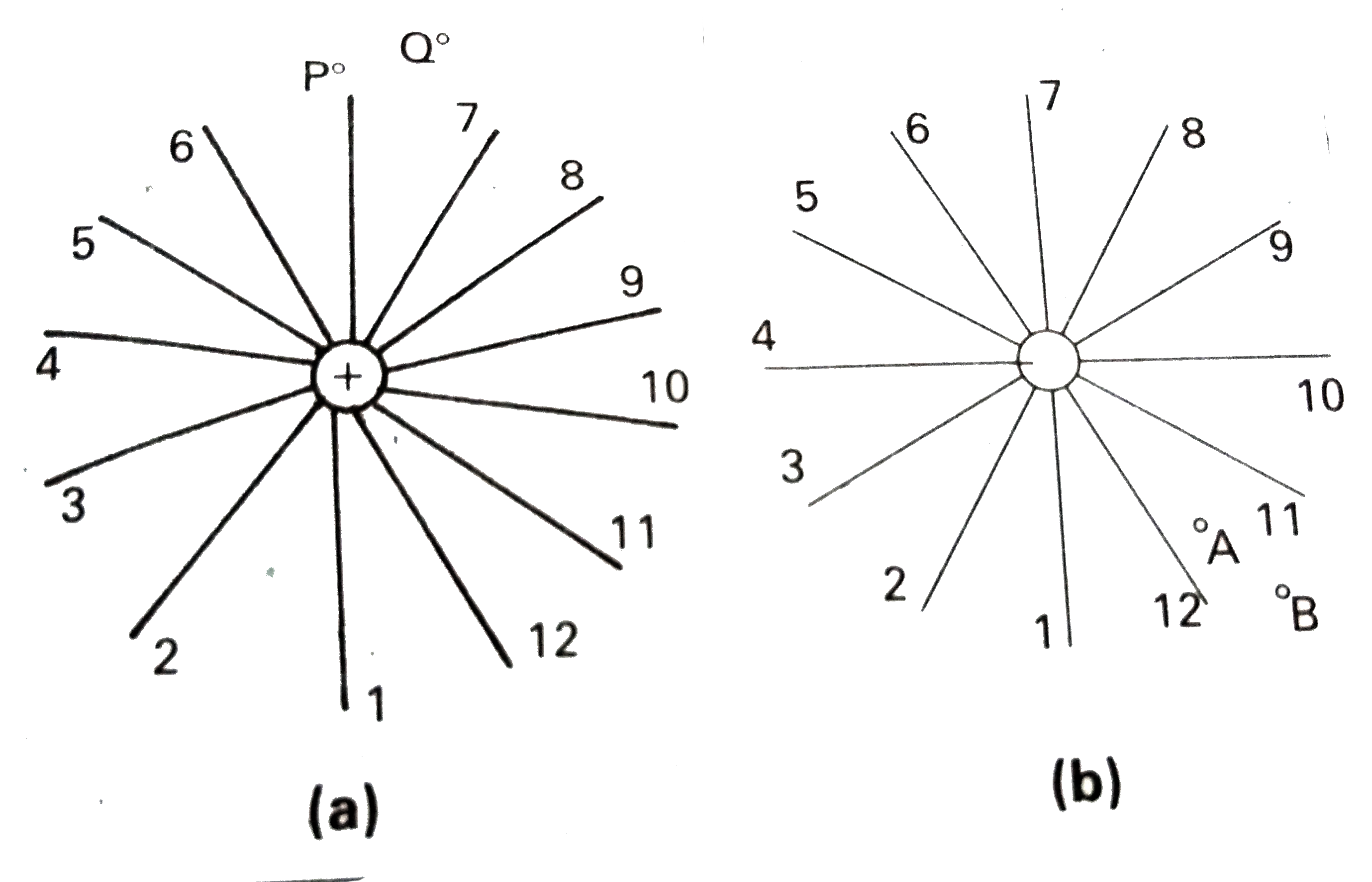An electrical technician requires a capacitance of 2μF in a circuit across a potential difference of 1kV. A large number of 1μFcapacitors are available to him each of which can withstand a potential difference of not more than 400V. Suggest a possible arrangement that requires the minimum number of capacitors. Solution in Telugu
Here total capacitance, C=2μF
Potential difference V = 1Kv = 1000 volt
Capacity of each capacitor C1=1μF
Maximum potential difference acorss each V = 400 volt

Let n capacitors of 1μF each be connected in series in a row and m such rows be connected in parallel as shown in the figure. As potential difference in each row = 1000 volt
∴ Potential difference across each capacitor =1000n=400
∴n=1000400=2.5
As n has to be a whole number (not less than 2.5) therefore n = 3
Capacitance of each row of 3 condensors of 1μF
Each is series = 1/3
Total capacitance of m such rows in parallel =m3
∴m3=2(μF) or m = 6
n×m=3×6=18.
Hence 1μF capacitors should be connected in six parallel rows, each row containing three capactiros in series.
Topper's Solved these Questions
- ELECTROSTATIC POTENTIAL AND CAPACITANCEBook:VIKRAM PUBLICATION ( ANDHRA PUBLICATION)Chapter:ELECTROSTATIC POTENTIAL AND CAPACITANCEExercise:Textual Examples
Explore 10 Videos
- ELECTROSTATIC POTENTIAL AND CAPACITANCEBook:VIKRAM PUBLICATION ( ANDHRA PUBLICATION)Chapter:ELECTROSTATIC POTENTIAL AND CAPACITANCEExercise:Important Questions
Explore 3 Videos
- ELECTROSTATIC POTENTIAL AND CAPACITANCEBook:VIKRAM PUBLICATION ( ANDHRA PUBLICATION)Chapter:ELECTROSTATIC POTENTIAL AND CAPACITANCEExercise:Textual Exercises
Explore 11 Videos
- ELECTROMAGNETIC WAVEBook:VIKRAM PUBLICATION ( ANDHRA PUBLICATION)Chapter:ELECTROMAGNETIC WAVEExercise:ADDITIONAL EXERCISES
Explore 19 Videos
- MAGNETISM AND MATTERBook:VIKRAM PUBLICATION ( ANDHRA PUBLICATION)Chapter:MAGNETISM AND MATTERExercise:Additional Exercises
Explore 19 Videos
Similar Questions
Figure (a) and (b) shows the field lines of a positive and negative point charge respectively.

Give the signs of the potential difference Vp−VQ,VB−VA.
View SolutionThree capacitors of capacitances 1muF,2muF and 3muFare connected in parallel
(a) What is the ratio of charges ?
(b) What is the ratio of potential differences ?
View SolutionTwo charges 5×10−8Cand−3×10−8C are located 16 cm apart. At what point(s) on the line joining the two charges is the electric potential zero? Take the potential at infinity to be zero.
View SolutionSuppose that the electric field part of an electromagnetic wave in vacuum is E={(3.1 N/C) cos [(1.8 rad/m)y+{5.4×106 rad/s} t]} i.
What is the direction of propagation ?
View SolutionWhy does a paramagnetic sample display greater magnetisation (for the same magnetising field) when cooled?
View SolutionAn electric technicain requires a capacitance fo 2 muF in a circuit across a potential differences of 1 KV. A large number of 1 muF capacitors are available to him, each of which can withstand a potential difference of not more than 400V. Suggest a possible arrangement that requires minimum number of capacitors.
View SolutionA capacitance of 2 muF is required in an electrical circuit across a potential difference of 1.0 kV A large number of 1 muF capacitors are available which can withstand a potential difference of not more than 300 v . The minimum number of capacitors required to achieve this is
View SolutionAn electrical technician requires a capacitance of 2μF in a circuit across a potential difference of 1 kV. A large number of 1μF capacitors are available to him each of which can withstand a potential difference of not more than 400 V. Suggest a possible arrangement that requires the minimum number of capacitors.
View Solutionएक विघुत टेक्नीशियन को 1KV विभान्तर के परिपथ में 2μF संधारित्र की आवश्यकता है। 1μF के संधारित्र इसे प्रचुर संख्या में उपलब्ध हैं जो 400V से अधिक का विभान्तर सहन नहीं कर सकते। कोई संभव विन्यास सुझाइए जिसमें न्यूनतम संधारित्रों की आवश्यकता हो।
View SolutionAn electric technician requires a capacitance of 2μF in a circuit across a potential difference of 1kV. A large number of 1μF capacitors are available to him each of which can withstand a potential difference of not more than 400V. Suggest a possible arrangement that requires the minimum number of capacitors.
View SolutionA capacitance of 2.0muF is required in an electrical circuit across a potential differences of 1.0 kV. A large number of 1muF capacitors are available which can withstand a potential differences of not more than 300V. The minimum number of capacitors required to achieve this is
View SolutionAn electrical technican requires a capacitance fo 2 muF in a circuit across a potential difference of 1kV. A large number 1muF capacitor are available to him each of which can withstand a potential difference of not more than 400V. Suggest a possible arrangement that requires the minimum number of capacitors.
View SolutionAn electrical technician requires a capacitance of 2 µF in a circuit across a potential difference of 1 kV. A large number of 1 µF capacitors are available to him each of which can withstand a potential difference of not more than 400 V. Suggest a possible arrangement that requires the minimum number of capacitors.
View SolutionAn electrical technician requires a capacitance of 2 µF in a circuit across a potential difference of 1 kV. A large number of 1 µF capacitors are available to him each of which can withstand a potential difference of not more than 400 V. Suggest a possible arrangement that requires the minimum number of capacitors.
View SolutionAn electrical technician requires a capacitance of 2 µF in a circuit across a potential difference of 1 kV. A large number of 1 µF capacitors are available to him each of which can withstand a potential difference of not more than 400 V. Suggest a possible arrangement that requires the minimum number of capacitors.
View Solution

